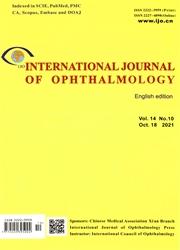Clinical characteristics of peripapillary hyperreflective ovoid mass-like structures in myopic children
IF 1.9
4区 医学
Q2 OPHTHALMOLOGY
引用次数: 0
Abstract
AIM: To describe the characteristics of peripapillary hyperreflective ovoid mass-like structure (PHOMS) in myopic children and to investigate factors associated with PHOMS. METHODS: This retrospective observational study included 101 eyes of 101 children (age ≤17y) with myopia. All included patients underwent comprehensive clinical examination. Optic nerve canal parameters, including disc diameter, optic nerve head (ONH) tilt angle, and border tissue angle were measured using serial enhanced-depth imaging spectral-domain optical coherence tomography (EDI-OCT). Based on the optic disc drusen consortium's definition of PHOMS, eyes were classified as PHOMS group and non-PHOMS group. PHOMS was categorized according to height. RESULTS: Sixty-seven (66.3%) eyes were found with PHOMS. Small PHOMS could only be detected by optical coherence tomography (OCT). Medium PHOMS could be seen with blurred optic disc borders corresponding to OCT. The most frequent location of PHOMS was at the nasosuperior (91%, 61 of 67 eyes) to ONH disc. The axial length and spherical equivalent were more myopic in the PHOMS group than in the non-PHOMS group (both P<0.001). ONH tilt angle was also significantly greater in PHOMS group than in non-PHOMS group [8.90 (7.16-10.54) vs 3.93 (3.09-5.25), P<0.001]. Border tissue angle was significantly smaller in PHOMS group than in non-PHOMS group [29.70 (20.90-43.81) vs 45.62 (35.18-60.45), P<0.001]. In the multivariable analysis, spherical equivalent (OR=3.246, 95%CI=1.209-8.718, P=0.019) and ONH tilt angle (OR=3.275, 95%CI=1.422-7.542, P=0.005) were significantly correlated with PHOMS. There was no disc diameter associated with PHOMS. In the linear regression analysis, border tissue angle was negatively associated with PHOMS height (β=-2.227, P<0.001). CONCLUSION: PHOMS is associated with optic disc tilt and optic disc nasal shift in myopia. Disc diameter is not a risk factor for PHOMS. The changes in ONH caused by axial elongation facilitated an understanding of the mechanism of PHOMS.近视儿童毛细血管周围高反射卵圆形肿块样结构的临床特征
目的:描述近视儿童毛细血管周围高反射卵圆形肿块样结构(PHOMS)的特征,并研究与PHOMS相关的因素。方法:这项回顾性观察研究共纳入101名近视儿童(年龄≤17岁)的101只眼睛。所有患者均接受了全面的临床检查。使用连续增强深度成像光谱域光学相干断层扫描(EDI-OCT)测量视神经管参数,包括视盘直径、视神经头(ONH)倾斜角和边界组织角。根据视盘色素沉着联盟对 PHOMS 的定义,眼睛被分为 PHOMS 组和非 PHOMS 组。结果:67只眼睛(66.3%)患有PHOMS。小PHOMS只能通过光学相干断层扫描(OCT)检测到。中型 PHOMS 可通过与 OCT 相对应的模糊视盘边界看到。PHOMS最常出现的位置是在鼻腔上方(67眼中有61眼,占91%)至视神经乳头圆盘处。与非PHOMS组相比,PHOMS组的轴长和球面等值近视度数更高(均P<0.001)。PHOMS组的ONH倾斜角也明显大于非PHOMS组[8.90 (7.16-10.54) vs 3.93 (3.09-5.25),P<0.001]。PHOMS组的边界组织角明显小于非PHOMS组[29.70 (20.90-43.81) vs 45.62 (35.18-60.45),P<0.001]。在多变量分析中,球面等值(OR=3.246,95%CI=1.209-8.718,P=0.019)和 ONH 倾斜角(OR=3.275,95%CI=1.422-7.542,P=0.005)与 PHOMS 显著相关。椎间盘直径与 PHOMS 无关。在线性回归分析中,边界组织角与 PHOMS 高度呈负相关(β=-2.227,P<0.001)。视盘直径不是 PHOMS 的危险因素。轴向拉长引起的视网膜上皮的变化有助于理解PHOMS的机制。
本文章由计算机程序翻译,如有差异,请以英文原文为准。
求助全文
约1分钟内获得全文
求助全文
来源期刊

International journal of ophthalmology
Medicine-Ophthalmology
CiteScore
2.50
自引率
7.10%
发文量
3141
审稿时长
4-8 weeks
期刊介绍:
· International Journal of Ophthalmology-IJO (English edition) is a global ophthalmological scientific publication
and a peer-reviewed open access periodical (ISSN 2222-3959 print, ISSN 2227-4898 online).
This journal is sponsored by Chinese Medical Association Xi’an Branch and obtains guidance and support from
WHO and ICO (International Council of Ophthalmology). It has been indexed in SCIE, PubMed,
PubMed-Central, Chemical Abstracts, Scopus, EMBASE , and DOAJ. IJO JCR IF in 2017 is 1.166.
IJO was established in 2008, with editorial office in Xi’an, China. It is a monthly publication. General Scientific
Advisors include Prof. Hugh Taylor (President of ICO); Prof.Bruce Spivey (Immediate Past President of ICO);
Prof.Mark Tso (Ex-Vice President of ICO) and Prof.Daiming Fan (Academician and Vice President,
Chinese Academy of Engineering.
International Scientific Advisors include Prof. Serge Resnikoff (WHO Senior Speciatist for Prevention of
blindness), Prof. Chi-Chao Chan (National Eye Institute, USA) and Prof. Richard L Abbott (Ex-President of
AAO/PAAO) et al.
Honorary Editors-in-Chief: Prof. Li-Xin Xie(Academician of Chinese Academy of
Engineering/Honorary President of Chinese Ophthalmological Society); Prof. Dennis Lam (President of APAO) and
Prof. Xiao-Xin Li (Ex-President of Chinese Ophthalmological Society).
Chief Editor: Prof. Xiu-Wen Hu (President of IJO Press).
Editors-in-Chief: Prof. Yan-Nian Hui (Ex-Director, Eye Institute of Chinese PLA) and
Prof. George Chiou (Founding chief editor of Journal of Ocular Pharmacology & Therapeutics).
Associate Editors-in-Chief include:
Prof. Ning-Li Wang (President Elect of APAO);
Prof. Ke Yao (President of Chinese Ophthalmological Society) ;
Prof.William Smiddy (Bascom Palmer Eye instituteUSA) ;
Prof.Joel Schuman (President of Association of University Professors of Ophthalmology,USA);
Prof.Yizhi Liu (Vice President of Chinese Ophtlalmology Society);
Prof.Yu-Sheng Wang (Director of Eye Institute of Chinese PLA);
Prof.Ling-Yun Cheng (Director of Ocular Pharmacology, Shiley Eye Center, USA).
IJO accepts contributions in English from all over the world. It includes mainly original articles and review articles,
both basic and clinical papers.
Instruction is Welcome Contribution is Welcome Citation is Welcome
Cooperation organization
International Council of Ophthalmology(ICO), PubMed, PMC, American Academy of Ophthalmology, Asia-Pacific, Thomson Reuters, The Charlesworth Group, Crossref,Scopus,Publons, DOAJ etc.
 求助内容:
求助内容: 应助结果提醒方式:
应助结果提醒方式:


